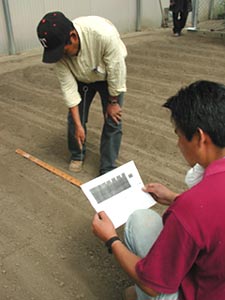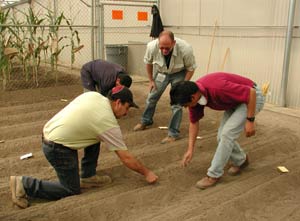March, 2004
 On 12 March 2004, CIMMYT took a modest but historic step in the development of drought tolerant wheat, when a small trial plot was sown to genetically modified (transgenic) wheat in a screenhouse at the Center’s headquarters in Texcoco, Mexico. This is the first time that transgenic wheat has been planted under field-like conditions in Mexico, and rigorous biosafety procedures are being followed.
On 12 March 2004, CIMMYT took a modest but historic step in the development of drought tolerant wheat, when a small trial plot was sown to genetically modified (transgenic) wheat in a screenhouse at the Center’s headquarters in Texcoco, Mexico. This is the first time that transgenic wheat has been planted under field-like conditions in Mexico, and rigorous biosafety procedures are being followed.
Drought is arguably the world’s most important agricultural production problem. In developing countries, millions of hectares of wheat are grown in areas that often experience drought, and the problem is projected to worsen with climate change. A plant’s ability to withstand dry conditions at critical periods in its growth can make the difference between food and famine for poor households. Developing drought-tolerant wheat and maize varieties that perform well under diverse conditions is a top priority at CIMMYT, where innovative research—conventional as well as transgenic—is pursued to meet this complex and difficult challenge.
CIMMYT researchers have well-founded hopes that the wheat they are testing will withstand serious droughts. This wheat carries the DREB1A gene from the plant Arabidopsis thaliana. The gene has been shown to confer tolerance to drought, low temperatures, and salinity in Arabidopsis, a plant species related to wild mustard (see Nature Biotechnology 17:287-291).

Previous experiments with DREB wheat grown in pots in CIMMYT’s biosafety greenhouse provided very encouraging results. The new screenhouse trial will enable researchers to see whether the DREB wheat responds similarly under more “natural” conditions.
This trial is the first time that a food crop carrying the DREB gene has advanced to this level of testing. If the results are positive, there are major implications for its use in other cereal crops, such as rice, maize, and barley. CIMMYT is considering testing the DREB gene in the drought-tolerant wheat it has developed through conventional breeding, to see if the resulting plants can use water even more efficiently.
  |
| A comparison of DREB and control wheat plants (DREB plants on the left, control plants on the right in both of the above photographs), after 10 days without water. |
The promising work with the DREB wheat would not have been possible without the generosity of the Japan International Research Center for Agricultural Sciences (JIRCAS), which provided the gene construct, and funding from Australia’s Molecular Plant Breeding-Cooperative Research Centre.
The transgenic wheat trials were approved in December 2003 by Mexican authorities under strict biosafety provisions to ensure that the plants do not inadvertently cross with conventional wheat plants:
- Access to the enclosed screenhouse trial is tightly restricted.
- No wheat plants are grown within 10 meters of the screenhouse trial.
- The spikes (flowers) of the plants are covered and isolated from the environment by glassine bags.
- Plant materials are destroyed in an autoclave at the end of the trial.
- The trial is monitored by Mexican authorities and the CIMMYT Biosafety Officer.
But the greatest biosafety measures are provided by the wheat plant itself. Wheat is a “perfectly self-pollinated crop,” with 99% of fertilization occurring within the sheathed spike of the plant, where male and female plant components share the same floret. Even in conventional breeding, researchers have to resort to a series of carefully executed, laborious procedures to cross one wheat plant with another. This makes wheat very different from maize, which freely pollinates and thus exchanges genes with other maize plants. Cross-pollination is further limited because wheat pollen is heavy and does not travel far, and because the pollen remains viable for only 20-30 minutes.
Details
CIMMYT Research Team
Alessandro Pellegrineschi, Matthew Reynolds, Richard Trethowan, Mario Pacheco, Rosa Maria Brito, Rosaura Almeraya, Scott McLean, and David Hoisington.
Trial Purpose
To evaluate the performance under water-stress and normal irrigation conditions of transgenic bread wheat lines containing the Arabidopsis thaliana DREB1A under the control of the stress inducible promoter rd29a.
Trial Design
MPB-Bobwhite26 lines, each containing the DREB1A gene driven by the rd29A promoter are planted in a randomized lattice design. The non-transformed MPB-Bobwhite26 line is used as a control and 10 drought tolerant lines are used for comparison purposes. Two water regimes are being evaluated: full irrigation versus no irrigation, except one at planting.
For further information, contact Dr. Alessandro Pellegrineschi
Download pdf version (170 KB)
 Capacity development
Capacity development 
